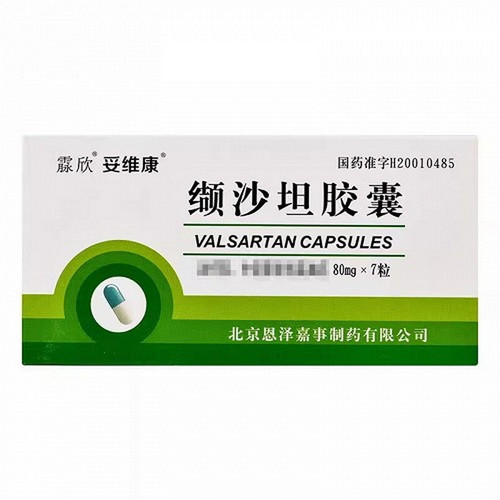Product Overview
[Drug Name]
Generic Name: Valsartan Capsules
Trade Name: Lizhuweike
English Name: Valsartan Capsules
Chinese Pinyin: Xiashatan Jiaonang
[Ingredients]
Valsartan.
[Properties]
This product is a hard capsule containing a white powder.
[Indications]
Valsartan is indicated for all types of mild to moderate hypertension, especially for patients intolerant to ACE inhibitors.
[Dosage and Administration]
1. The recommended dose is 80 mg once daily, regardless of gender, age, or race. The antihypertensive effect appears within 2 weeks, reaching its maximum effect after 4 weeks. For patients with inadequate blood pressure control, the daily dose can be increased to 160 mg or a diuretic can be added. This drug can be used in combination with other antihypertensive agents.
2. No dose adjustment is required for patients with mild to moderate renal impairment or non-biliary or non-cholestatic hepatic insufficiency.
3. No dose adjustment is required for elderly patients.
4. No safety and efficacy data are available for pediatric patients. 5. This drug lowers blood pressure in patients with hypertension without affecting heart rate.
6. Abrupt discontinuation of this drug does not result in rebound blood pressure or other clinical adverse reactions.
7. Multiple doses of this drug have no significant effect on total cholesterol, fasting triglycerides, fasting blood glucose, or uric acid.
[Adverse Reactions]
1. The overall incidence of adverse reactions with this drug is similar to that observed in the placebo group. The main adverse reactions observed in clinical use include headache, dizziness, viral infection, upper respiratory tract infection, cough, diarrhea, fatigue, rhinitis, back pain, nausea, pharyngitis, and arthralgia. The incidence of adverse reactions is not related to dose or duration of treatment, nor to gender, age, or race. It is unknown whether these reactions are causally related to treatment with this drug. 2. Laboratory Indicators: This drug may occasionally cause a decrease in hemoglobin and hematocrit. In controlled clinical trials, patients taking this drug experienced a significant decrease in hematocrit and hemoglobin, at 0.8% and 0.4%, respectively, compared to 0.1% in the placebo group. Neutropenia occurred in 1.9% of patients taking this drug and 1.8% of patients taking ACE inhibitors. In controlled clinical trials, significant elevations in serum creatinine, serum potassium, and total bilirubin occurred in 0.8%, 4.4%, and 6% of patients taking this drug, respectively, compared to 1.6%, 6.4%, and 12.9% of patients taking ACE inhibitors, respectively. Elevated liver function tests have occasionally been reported in patients taking this drug. No specific laboratory parameters need to be monitored when treating patients with essential hypertension.
[Contraindications]
This drug is contraindicated in patients with known hypersensitivity to it; it is contraindicated in pregnant and lactating women.
[Precautions]
1. Patients with Hyponatremia or Volume Depletion: Patients with severe sodium deficiency and/or volume depletion (e.g., due to high-dose diuretics) may experience symptomatic hypotension when initiating treatment with valsartan. Therefore, hyponatremia or hypovolemia must be corrected before starting this drug. If hypotension occurs, the patient should be placed in a supine position and, if necessary, administered intravenously with normal saline. Transient hypotension does not preclude further treatment; treatment can be continued once blood pressure stabilizes. 2. Patients with Hepatic Impairment: Approximately 70% of valsartan is eliminated unchanged in the bile. Valsartan is not biotransformed, so its systemic effects are unrelated to impaired liver function. Therefore, no dose adjustment is required in patients with non-biliary or non-cholestatic forms of hepatic impairment. However, patients with biliary cirrhosis or biliary obstruction have reduced valsartan clearance (higher AUCs), so caution should be exercised when using valsartan in these patients. 3. Patients with Renal Impairment: Because renal clearance of valsartan accounts for only 30% of total plasma clearance, its systemic effects are unrelated to renal function. No dose adjustment is required in patients with renal impairment. Inhibition of the renin-angiotensin-aldosterone system may alter renal function in sensitive patients. In patients whose renal function depends on the activity of the renin-angiotensin-aldosterone system (such as those with severe congestive heart failure), treatment with angiotensin-converting enzyme inhibitors or angiotensin receptor antagonists may result in oliguria and/or progressive azotemia and (rarely) acute renal failure and/or death. Therefore, patients with severe renal insufficiency (creatinine clearance 10 ml/min) should use this drug with caution. Short-term use of valsartan in 12 patients with renal hypertension due to unilateral renal artery stenosis showed no significant changes in renal hemodynamics, serum creatinine, or blood urea nitrogen. Long-term use of valsartan has not been studied in patients with unilateral or bilateral renal artery stenosis. Because drugs that affect the renin-angiotensin-aldosterone system may increase serum creatinine or blood urea nitrogen in patients with unilateral or bilateral renal artery stenosis, these parameters should be carefully monitored for safety reasons. 4. No mutagenic, mitogenic, or carcinogenic effects have been identified. 5. Keep this drug out of the reach of children. 6. Used drug packaging should not be discarded.
[Use in Special Populations]
Precautions for Pediatric Patients: Efficacy and safety data for pediatric patients are available.
Precautions for Pregnancy and Lactation: Contraindicated.
Precautions for Elderly Patients: See [Dosage and Administration] and [Precautions].
[Drug Interactions]
Clinical trials have not revealed any clinically significant interactions between this drug and the following drugs: cimetidine, warfarin, furosemide, digoxin, atenolol, indomethacin, hydrochlorothiazide, amlodipine, and glyburide. This drug generally has no clinically significant interactions with metabolic inducers or inhibitors of the cytochrome P450 enzyme system. In vitro studies have shown no interactions with other drugs with high plasma protein binding, such as diclofenac, furosemide, and warfarin. Concomitant use with potassium-sparing diuretics (e.g., spironolactone, triamterene, amiloride), potassium preparations, or potassium-containing salt substitutes may increase serum potassium. If coadministration is necessary, monitor carefully.
[Pharmacological Actions]
This drug is an antagonist of the angiotensin II (Ang II) receptor AT1. It selectively blocks the binding of Ang II to the AT1 receptor, inhibiting vasoconstriction and aldosterone release, resulting in a hypotensive effect.
[Storage] Store in a dark, sealed, cool place (not exceeding 20°C).
[Strength] 80mg
[Expiry Period] 24 months
[Approval Number] National Medicine Standard H20000622
[Manufacturer] Company Name: Livzon Pharmaceutical Factory, Livzon Group








